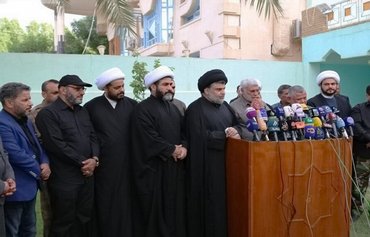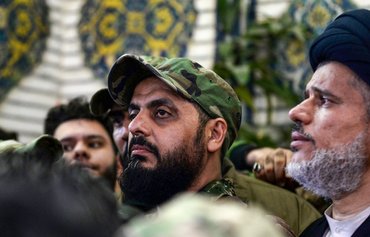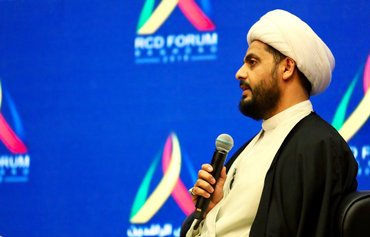Divisions among armed factions sponsored by Iran's "Islamic Revolutionary Guard Corps" (IRGC) are on the rise in eastern Syria as mounting US sanctions force a cut in IRGC expenditures on foreign operations, experts told Diyaruna.
The fissures are primarily surfacing between Iraqi militia Kataib Hizbullah and IRGC commanders as well as other proxy groups vying for power and influence in the region, they said.
Observers attributed these divisions primarily to the frenzied competition for leadership and sources of wealth and influence among the dominant parties on the ground.
Iraqi militias are mainly concentrated in eastern Syria, with around 20 militias operating there. Aside from Kataib Hizbullah, the most prominent militias are al-Nujaba, Zulfiqar Brigade, Haidariyoun and Sayed al-Shuhada Brigades.
Iranian, Afghan (Fatemiyoun), Pakistani (Zainabiyoun) and Lebanese militias are also competing for a foothold.
'Each side seeks to dominate the other'
IRGC-backed militias, even those comprised of Iraqi nationals, accuse Kataib Hizbullah of arrogantly side-stepping them and adopting unilateral decisions.
"These differences have emerged more so than ever before as each side seeks to dominate the other and impose its influence and control over the decision making process," said Sheikh Mudar al-Asad, a member of the Syrian Tribal Council.
"Today, there is sharp division and internal conflict among the entities loyal to Iran as they compete for leadership, acquisition of land and natural resources in Syria's east -- mainly oil and gas," he told Diyaruna.
"The gradual decline of funds dispensed to Iran's proxies because of the impact of the economic sanctions on the Iranian and Syrian regimes" has led to the emergence of divisions to the surface, al-Asad said.
Tensions are high between the IRGC's leadership in Syria and allied militias, particularly Kataib Hizbullah -- who saw their monthly salary go down from $1,500 to less than $300 per fighter.
Moreover, the constant bombardment of Iranian proxies' positions in the Euphrates Valley has contributed to heightened tensions and frustration, he said.
The situation in areas where Iran-backed militias are influential has considerably worsened, said al-Asad.
"Residents of cities and towns in eastern Syria such as al-Mayadeen, al-Kasra, Deir Ezzor, al-Shamiya, Albu Kamal, al-Maraiah and al-Tabani have suffered greatly from the violations committed by these groups," he said.
They seize property and land and steal agricultural crops, he said. As a result, many residents were forced to leave their area amid food shortages, militia-imposed taxes and economic stagnation.
Financial distress deepens divisions
"Kataib Hizbullah is one of the IRGC's fiercest agents, whether in Iraq or Syria," said Syrian political analyst Ziyad Al-Munjid.
The differences that have emerged between them have not yet affected the strategic nature of their relationship, but are often centered around "tactical or personal matters", he told Diyaruna.
However, the continued financial distress that these militias are experiencing is expected to "deepen divisions among them and make their internal front more fragile, as it is widely known that Iran had been generously funding these groups for years", he said.
Things have now changed, he said, and the fighters who joined these groups, especially poor Syrians, are now complaining about their low wages as many of them initially joined out of need for money rather than ideology.
"Iran-backed groups will go to any length to protect their economic interests," he said. "They have been draining the wealth of the local population since they imposed their control over eastern Syria regions."
"They have also been implementing demographic change in these areas by acquiring real estate to house their fighters and their families, with the ultimate goal of serving Iran's agenda."
Soleimani's shoes hard to fill
Iraqi political analyst Ghanem al-Abed said "the tension between Iran's proxies in Syria is nothing but a reflection of the state of rivalry that prevails among them in Iraq since the assassination of Iranian general Qassem Soleimani in January".
"Esmail Qaani, who replaced Soleimani, is still unable to fill the void left by his predecessor and cannot restore matters to the way they were," he told Diyaruna.
The competition for leadership is accelerating on a daily basis, he said, adding that certain factions have "started carrying out unilateral actions without consulting IRGC leadership".
Iran has been trying for quite some time to tighten its grip on the border regions between Iraq and Syria and bolster its strategic presence there, said al-Abed.
"During the past few months, Iran has established three new camps for its proxy groups in the border region," he said, adding that this is bound to increase the pace of smuggling through informal crossings and help it recuperate some of the losses it has sustained from the sanctions.

![Members of Kataib Hizbullah and other Iraqi militias are seen on the outskirts of the Syrian city of Albu Kamal in November 2017. [Photo circulated online]](/cnmi_di/images/2020/09/11/26013-kh-syria-iran-600_384.jpg)






